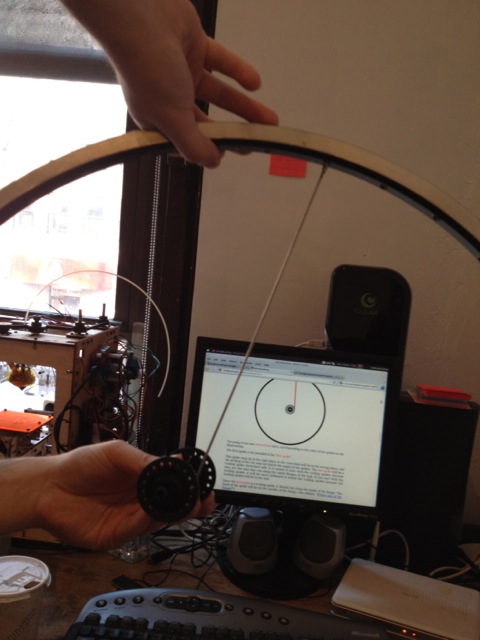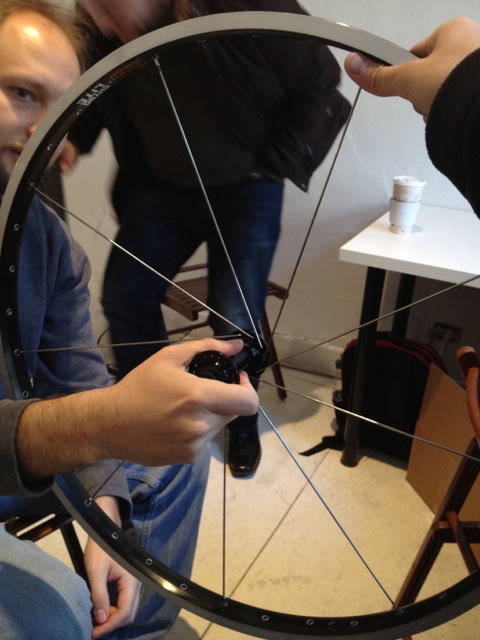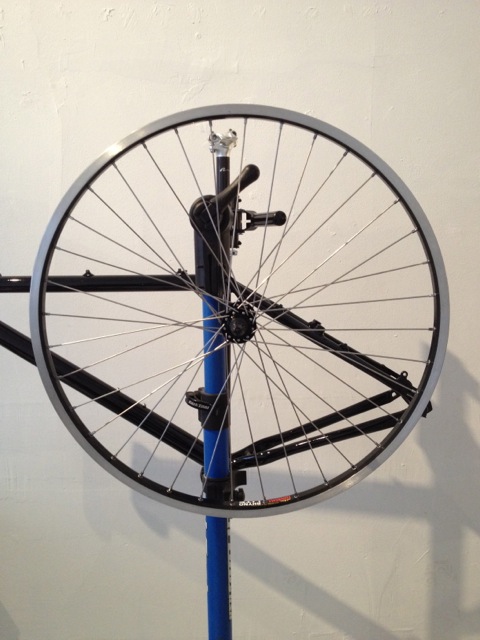Bike workshop
We are going to build a bike for Guan.
Build photos
Parts guide
- Each of the bearings
- Bottom bracket - According to the site 68mm english thread. Your bottom bracket will also need to be compatible with your crankset. Some cranksets have integrated bottom brackets in which case you won't need to get this.
- Headset - 1 1/8 inch threadless headset, pretty standard for mountain bikes. There are some amazingly expensive headsets but you don't need your handlebars to swivel that smoothly. A simple but decent one like a Cane Creek will do fine
- Drivetrain parts
- Crankset - This is basically the front gears (in the front they're called chainrings) along with the crank arms, they're typically sold together If you only want a few rear gears get a single speed crankset. If you'd like to go for full gearing get a double or triple. You can play with the number of teeth in the chainrings and also the length of the crank arms. The thickness of the chainring also has to match your chain type which I'll get to later.
- Front derailleur - Only necessary if you have a double or triple crankset. I can see from the bosses on the frame that this is a top cable run, which means the front derailleur would need to be top pull (designed so the cable pulls a lever from above, also typical for mountain bikes). This frame does not have welded on mount points for a derailleur, so you'd need to get a clamp on (once again typical for mtb)
- Rear cassette - The set of rear gears (known as cogs). Typically they're welded together as one piece, on high end stuff they're separate cogs that slot together. They will need to be compatible with the hub you have on your rear wheel, as they slot onto it. There is one main MTB standard, but occasionally you run into something proprietary. If you're going with an internal geared hub, don't worry about this. The hub will come with one integrated cog.
- Rear derailleur - Also not necessary if you're going internally geared. If you do go multi-cog however, get one that's compatible with your cassette (same number of cogs, same spacing standard (for MTB pretty much Shimano or SRAM, everyone else follows their standards))
- Chain - Chains have to be the right width for the number of cogs you have. Chains 8 speed and below are all the same. 9 and up each have their own size. Cheap MTBs use 8 speed chains, decent ones usually have 9. 10 is typically reserved for road bikes, but some very high end MTBs have them. I've never seen an 11 on an MTB. Your chainring also needs to match this width.
- Wheels - You can buy prebuilt wheels, but that's not as fun. If you want to get prebuilt wheels just make sure they are compatible with your drivetrain. Otherwise
- Hubs - Front hub only has compatibility issues if you want disc brakes. Otherwise it can be whatever you want. Your rear hub at the very least needs to be compatible with your cassette. If you're getting an internally geared hub that's not an issue.
- Rims - 26 inch. There are some rims that are "disc specific", meaning they don't have flats on the sides for traditional brakes because you're expected to get disc brakes. Don't bother, even if you get disc brakes. They're expensive and actually weaker.
- Spokes - These need to be precisely sized to your rim/hub combo, and each wheel side (rear left, rear right, front left, front right) will probably have its own size. There are calculators online to figure out what spoke lengths you need based on your rim and hub specs. Get these later from a local shop. If you buy them online you'll have to get four boxes of 100 for each size. A shop will have all the sizes and usually sell them for like $0.50 a piece or so.
- Saddle
- Seatpost - Diameter is 27.2mm, everything else you can play with
- Post clamp - The picture has one already on the frame but if it doesn't really come with one you can order a 27.2mm one
- Saddle - No compatibility issues here, just get whatever's comfortable
- Fork - Make sure it fits 26 inch wheels, and has mount points for whichever brake type you decide to get, disc dropouts if you get discs, Cantilever bosses for anything else you're likely to get
- Brakes - Need to be compatible with your brake levers, either short pull or long pull (1/1 actuation or 1/2 actuation, long pull is more common on MTB components, road bikes are all short pull)
- Disc brakes - The most powerful and don't get slowed when your rims get wet, but overkill in the city, they come in hydraulic or mechanical (cables like everything else) form. Mechanical discs are long pull
- Cantilever - The most effective rim brakes but a huge pain to adjust. I have cantis and they're a mixed blessing. Cantis are short pull
- V-brakes - Vast majority of low to mid range MTBs have V brakes. They mount to the same points as cantis but are long pull
- Handlebars - Nothing special here. They have lightweight carbon whatever bars, but its not worth the price increase. I may have a spare old one lying around. They have versions that rise up to make your posture more upright
- Stem - Bar connecting your fork to your handlebars. Again, don't get anything special here. Needs to be a threadless stem.
- Stuff on your handlebars
- Grips
- Brake levers - make sure they're compatible with your brakes
- Shifters - Need to be compatible with your derailleurs or your gearhub. Usually that's shimano or SRAM standard
- you can get the shifters and levers integrated in one piece
- Cables
- shifter cables - I swear by jagwire cables, amazingly rust resistant
- brake cables - they are different believe it or not
- shifter cable housings - Better housings make a huge difference in the responsiveness of shifting because they flex less
- brake cable housings
- housing caps and cable caps - I have bottles of hundreds of these
Guan's bike
Parts
| Part | Manufacturer | Model | Price | Arrived |
|---|---|---|---|---|
| Frame | Kinesis | 26" aluminum | $184.95 | Yes |
| Hub | Sturmey Archer | S30 3-speed with shifter, cable | $69.89 | Yes |
| Headset | Cane Creek | 10-Series | $31.89 | Yes |
| Crankset | Nashbar | MT2 Mountain Bike Crankset | $51.00 | Yes |
| Bottom bracket | Nashbar | ISIS Bottom Bracket | $23.79 | Yes |
| Chain | SRAM | PC 870 P-link 8-speed | $17.46 | Yes |
| Front hub | Shimano | Deore M590 | $16.76 | |
| Rims | Sun | Rhyno Lite | $54.40 | |
| Spokes | Wheelsmith | 2.0mm, 260mm rear and 267mm front | Yes | |
| Seatpost | Nashbar | Carbon Fiber Seatpost | $32.00 | Yes |
| Saddle | Schwinn | Pillow Top Cruiser | $19.99 | Yes |
| Fork | Nashbar | Rigid Mountain Bike Fork | $40.00 | Yes |
| Brakes | Shimano | Acera BR-M422 | $22.28 | Yes |
| Stem | Nashbar | Deluxe 31.8mm Alloy Stem | $12.00 | Yes |
| Handlebars | Nashbar | Comfort Mountain Bike Handlebars | $20.00 | Yes |
| Grips | Nashbar | Gel Grips | $8.00 | Yes |
| Brake levers | Avid | FR-5 | $13.63 | Yes |
| Brake cables and housings | XLC | universal | $11.04 | Yes |
| Shifter cable housings | included | |||
| Housing caps | ||||
| Cable caps | ||||
Measurements
Spokes
Required dimensions:
- Effective rim diameter (549mm)
- Hub flange diameter: This is a measurement between the center of one spoke hole to the center of another spoke hole on the opposite side of the same hub flange
- Hub center to flange center
- Hub spoke hole diameter
- Number of spokes: 36
- Cross pattern: cross 3
Hub center to flange center:
This dimension requires two measuring steps - First, measure the over-locknut dimension (O.L.D.) of the hub, from the outside face of the left locknut to the outside face of the right locknut, in millimeters. Then, working with one side of the hub first, then the other, measure from the face of the locknut to the center of the flange on the same side of the hub, then subtract that number from half the over-locknut dimension using the following formula:
- Left Center to Flange = (O.L.D. / 2) - Left Locknut to Left Flange
- Right Center to Flange = (O.L.D. / 2) - Right Locknut to Right Flange
If using off-center spoke hole style rims you must also do the following:
1. Take an outside measurement of the rim to get its overall width, then divide that by 2 to get the location of the centerline of the rim.
2: Measure from the center of the rim to the centerline of the spoke holes (the imaginary line that runs between the offset holes in the rim). This value will be used in Step 3.
3. For the non-drive side, subtract the value derived from Step 2 from the non-drive side center-to-flange value, and conversely, add the value derived from step 2 to the drive side center-to-flange value. You then use those values as input for left and right center-to-flange in the spoke length calculator.
Frame
| Bottom bracket | 68mm English threaded |
| Headtube | 1 1/8" |
| Seat post clamp | 31.8mm |
| Rear spacing | 135.0mm |
Hub
| Axle length | 175mm / 162.7mm (?) |
| Axle diameter | 13/32" slotted |
| Rear hub spacing (OLD) | 127mm |
| Spoke holes | 36 |
| Spoke compatibility | 13g or 14g |
| Sprocket teeth | 13T through 22T |
Fork
| Axle to crown | 453mm |
| Steerer length | 1 1/8" threadless 280mm |
| Axle | 9mm dropouts |
| Max. tire width | 3.0" |
Rims
| Weight | 565g |
| Width | 27.5mm |
| Hub Drilling | 36spokes |
| Rim Depth | 16mm |
| Brake Compatibility | Rim Brake |
| Manufacturer Spec ERD | 549mm |
| Valve | Presta |
| ISO Diameter | 559 / 26" mtn |
| Valve Length | Short 32-40mm |
| Wheel Size | 26" |
| Tire Type | Clincher |
| Rim Center Offset | 0mm |
| Rim Material | Alloy |
| Rim Joint | Pinned/Sleeved |
| Brake Track | Non-Machined |
Front hub
| Axle type | 9mm |
| OLN | 100mm |
| Spoke hole diameter | 2.5mm |
| Left/right flange diameter | 38.5mm |
| Left/right flange offset | 34.5mm |


